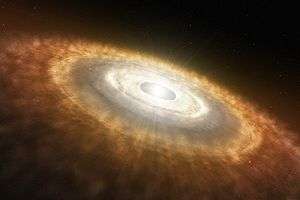Q-PACE
CubeSat Particle Aggregation and Collision Experiment (Q-PACE) or Cu-PACE,[5] is a planned orbital spacecraft mission that will study the early stages of proto-planetary accretion by observing particle dynamical aggregation for several years.
| Mission type | Astrophysics |
|---|---|
| Operator | University of Central Florida |
| Website | sciences |
| Mission duration | 3 years[1] |
| Spacecraft properties | |
| Spacecraft | Q-PACE |
| Bus | 3U CubeSat |
| Manufacturer | University of Central Florida |
| Launch mass | 3 kg (6.6 lb)[1] |
| Dimensions | 10 × 10 × 37.6 cm [1] |
| Power | solar panels, rechargeable battery |
| Start of mission | |
| Launch date | July 2020[2][3] |
| Rocket | LauncherOne[4] (air launch to orbit) |
| Launch site | Mojave Air and Space Port |
| Contractor | Virgin Galactic |
| Orbital parameters | |
| Reference system | Geocentric |
| Regime | Low Earth |
| Altitude | 500 km[1] |
Current hypotheses have trouble explaining how particles can grow larger than a few centimeters. This is called the meter size barrier. This mission was selected in 2015 as part of NASA's ELaNa program, and it is scheduled for launch in July 2020.[2]
Overview

Q-PACE is led by Joshua Colwell at the University of Central Florida and was selected NASA's CubeSat Launch Initiative which placed it on ELaNa XX.[6] The development of the mission was funded through NASA's Small Innovative Missions for Planetary Exploration (SIMPLEx) program.[7]
Observations of the collisional evolution and accretion of particles in a microgravity environment are necessary to elucidate the processes that lead to the formation of planetesimals (the building blocks of planets), km-size, and larger bodies, within the protoplanetary disk. The current hypotheses of planetesimal formation have difficulties in explaining how particles grow beyond one centimeter in size, so repeated experimentation in relevant conditions is necessary.[8]
Q-PACE will explore the fundamental properties of low‐velocity (< 10 centimetres per second (3.9 in/s)10 cm/s) particle collisions in a microgravity environment in an effort to better understand accretion in the protoplanetary disk.[9] Several precursor tests and flight missions were performed in suborbital flights as well as in the International Space Station.[1][10] The small spacecraft does not need accurate pointing or propulsion, which simplified the design.
An air launch to orbit from Virgin Galactic's Cosmic Girl airplane above the Mojave desert in California will send Q-PACE into space in July 2020.[2]
Objectives
The main objective of Q-PACE is to understand protoplanetary growth from pebbles to boulders by performing long-duration microgravity collision experiments. The specific goals are: [1]
- Quantify the energy damping in multi-particle systems at low collision speeds (< 1 millimetre per second (0.039 in/s) to 10 centimetres per second (3.9 in/s))
- Identify the influence of a size distribution on the collision outcome.
- Observe the influence of dust on a multi-particle system.
- Quantify statistically rare events: observe a large number of similar collisions to arrive at a probabilistic description of collisional outcomes.
Method
Q-PACE is a 3U CubeSat with a collision test chamber and several particle reservoirs that contain meteoritic chondrules, dust particles, dust aggregates, and larger spherical particles. Particles will be introduced into the test chamber for a series of separate experimental runs.
The scientists designed a series of experiments involving a broad range of particle size, density, surface properties, and collision velocities to observe collisional outcomes from bouncing to sticking as well as aggregate disruption in tens of thousands of collisions.[8][11] The test chamber will be mechanically agitated to induce collisions that will be recorded by on‐board video for downlink and analysis.[9] Long duration microgravity allows a very large number of collisions to be studied and produce statistically significant data.[1]
References
- Q-PACE: the CubeSat Particle Aggregation and Collision Experiment Archived 2019-01-19 at the Wayback Machine. (PDF) Josh Colwell, Julie Brisset, Addie Dove, Larry Roe, Jürgen Blum. University of Central Florida. August 2017.
- "Upcoming ELaNa CubeSat Launches". NASA. 6 May 2020. Retrieved 7 May 2020.
- Krebs, Gunter. "LauncherOne (L1)". Gunter's Space Page. Archived from the original on 27 April 2019. Retrieved 7 August 2019.
- Herrera, Chabeli (26 October 2018). "Virgin Orbit releases the first photos of its rocket-plane hybrid, LauncherOne". Orlando Sentinel. Archived from the original on 7 August 2019. Retrieved 7 August 2019.
- "NASA Announces Sixth Round of CubeSat Space Mission Candidates". NASA (Press release). 6 February 2015. Retrieved 24 June 2019.
- "Archived copy". NASA. Archived from the original on 17 June 2019. Retrieved 19 April 2020.CS1 maint: archived copy as title (link)
- Clark, Stephen (5 August 2019). "NASA's first interplanetary smallsats may struggle to stay under cost caps". Spaceflight Now. Archived from the original on 7 August 2019. Retrieved 7 August 2019.
- CubeSat Particle Aggregation Collision Experiment (Q-PACE): Design of a 3U CubeSat mission to investigate planetesimal formation. Stephanie Jarmak, Julie Brisset, Joshua Colwell, Adrienne Dove, etal. Acta Astronautica, Volume 155, February 2019, Pages 131-142. doi:10.1016/j.actaastro.2018.11.029
- Q‐PACE: the CubeSat Particle Aggregation and Collision Experiment. Archived 2019-12-17 at the Wayback Machine (PDF) Josh Colwell, Julie Brisset, Addie Dove, Larry Roe. January 2016.
- Planetesimal Formation Archived 2019-04-17 at the Wayback Machine. Center for Microgravity Research, University of Central Florida. Accessed on 2019.
- Krebs, Gunter. "Q-PACE (Cu-PACE)". Gunter's Space Page. Archived from the original on 17 April 2019. Retrieved 7 August 2019.
